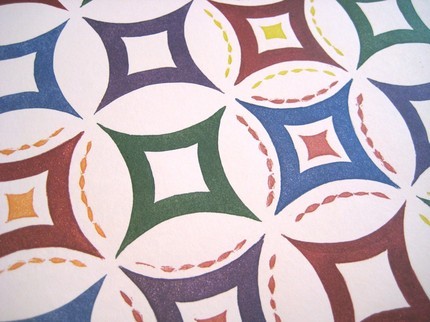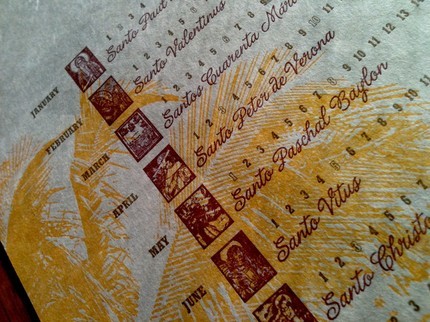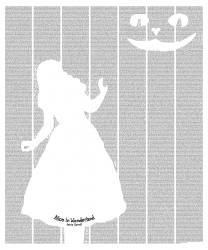I have a box full of paint chip sample cards from remodelling our house. What to do with them? I looked around on the web and found 2 interesting projects:
- Suzanne Heyd composed poems on the chips with a typewriter (that’s one to the right, more here). Phylum Press published a chapbook of her work called Crawl Space.
- Rachel Bergert‘s project 100 Colors, 100 Writings, 100 Days: Every day for one hundred days she picked a paint chip out of a bag and responded to it with a short writing. Here’s what she wrote in response to “bee pollen,” a pale yellow:
At some point in childhood, we start having memories, born of experience and not of photographs or family lore. Before I had memories, our attic had a wasp nest. It was discovered and fumigated but not removed. My first memories are of buzzing, of lying awake at night in terror, of the wasps that had surely returned.
See more entries here.
Do you know of other interesting projects using paint sample chips? — Let me know of any in the comments.
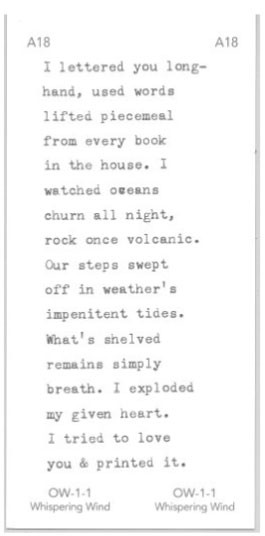
Page from Suzanne Heyd’s Crawl Space
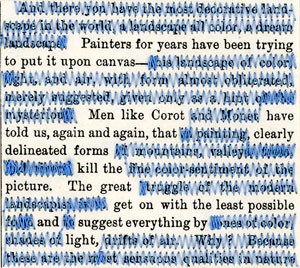 The Poetry Foundation recently posted an interview on their website with book artist Jen Bervin and poet Nancy Kuhl about small publishers producing poetry chapbooks — both the traditional form of pages sewn along a fold as well as more complicated artist’s books. It’s interesting for what they have to say about the state of the chapbook, although I spent more time exploring the links within the article to various bookworks. The Poetry Foundation recently posted an interview on their website with book artist Jen Bervin and poet Nancy Kuhl about small publishers producing poetry chapbooks — both the traditional form of pages sewn along a fold as well as more complicated artist’s books. It’s interesting for what they have to say about the state of the chapbook, although I spent more time exploring the links within the article to various bookworks.
 The page detail to the left is from Jen Bervin’s The Desert — “a poem (she) wrote by sewing row by row, line by line, across 130 pages of John Van Dyke’s, The Desert: Further Studies in Natural Appearances (1901).” Bervin uses sewing in many of her books — her website has good pictures and text about her editions. She talks in the interview and on her website about the small chapbooks Emily Dickinson made of her poems, as well as Dickinson’s use of punctuation and marks to indicate variants in her work. The Dickinson Fascicle is Bervin’s artist book in response to Dickinson’s work. Bervin also has an online-only artist book, A Non-Breaking Space. The page detail to the left is from Jen Bervin’s The Desert — “a poem (she) wrote by sewing row by row, line by line, across 130 pages of John Van Dyke’s, The Desert: Further Studies in Natural Appearances (1901).” Bervin uses sewing in many of her books — her website has good pictures and text about her editions. She talks in the interview and on her website about the small chapbooks Emily Dickinson made of her poems, as well as Dickinson’s use of punctuation and marks to indicate variants in her work. The Dickinson Fascicle is Bervin’s artist book in response to Dickinson’s work. Bervin also has an online-only artist book, A Non-Breaking Space.
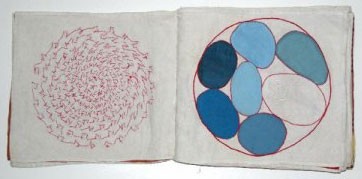 I recently read a post on the books arts listserv about an exhibition of fabric books by Louise Bourgeois. Since I didn’t know her bookwork, I poked around a bit to find out more. The spread to the left is from Ode à l’Oubli — what I especially like is that the sewing from the previous page shows through the back of the fabric sheet. Follow this link to see all the spreads. And this article from the NY Times talks about Ode à l’Oubli (“Ode to Forgetfulness”), “her 36-page fabric-on-fabric book, (with) an extraordinary and poignant object: a tactile diary of the long, trans-Atlantic, unusually examined life of the artist.” There’s also a book of her fabric-based work. I recently read a post on the books arts listserv about an exhibition of fabric books by Louise Bourgeois. Since I didn’t know her bookwork, I poked around a bit to find out more. The spread to the left is from Ode à l’Oubli — what I especially like is that the sewing from the previous page shows through the back of the fabric sheet. Follow this link to see all the spreads. And this article from the NY Times talks about Ode à l’Oubli (“Ode to Forgetfulness”), “her 36-page fabric-on-fabric book, (with) an extraordinary and poignant object: a tactile diary of the long, trans-Atlantic, unusually examined life of the artist.” There’s also a book of her fabric-based work.
| 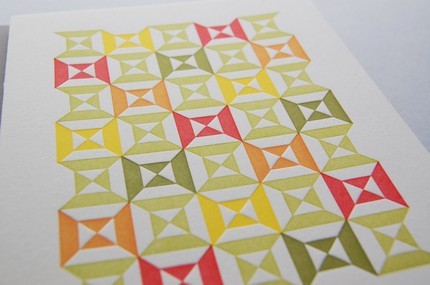
![]() The second one is an 11″x17″ broadside and 6 colors (!) by Cynthia Patrick in her Etsy shop here.
The second one is an 11″x17″ broadside and 6 colors (!) by Cynthia Patrick in her Etsy shop here.